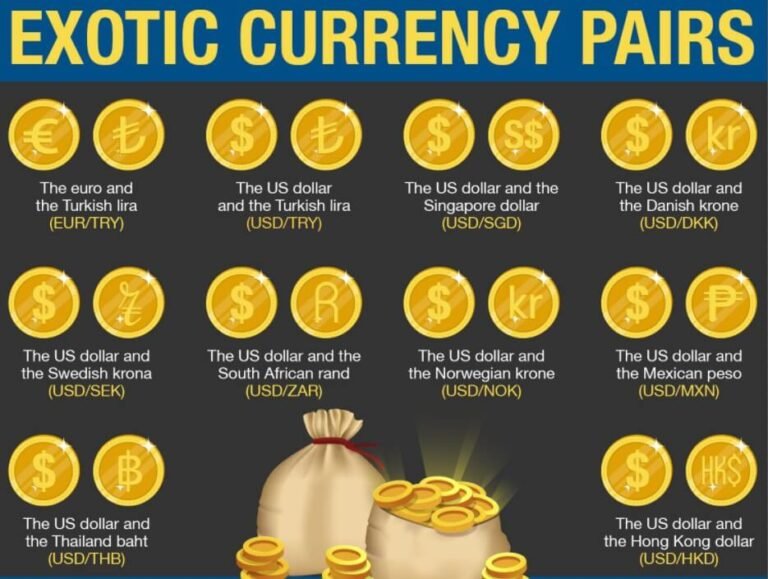Understanding Exotic Currency Pairs in Forex Trading
Introduction
The foreign exchange (forex) market is the largest and most liquid financial market in the world. While most traders are familiar with major and minor currency pairs, a lesser-known but increasingly popular segment is exotic currency pairs. These pairs offer unique opportunities—and risks—that make them appealing to certain types of traders. In this blog, we will explore what exotic currency pairs are, how they differ from major and minor pairs, and why they may or may not be suitable for your trading strategy.

Exotic currency pairs consist of one major currency (such as USD, EUR, or GBP) paired with the currency of a developing or emerging economy. Examples include:
USD/TRY (US Dollar / Turkish Lira)
EUR/THB (Euro / Thai Baht)
GBP/ZAR (British Pound / South African Rand)
USD/INR (US Dollar / Indian Rupee)
USD/MXN (US Dollar / Mexican Peso)
These pairs are called “exotic” not because they are rare, but because the economies they represent have less trading volume, higher volatility, and lower liquidity compared to majors and minors.
1. Lower Liquidity
Exotic pairs are not traded as frequently as major pairs. This lower liquidity can lead to wider spreads and price slippage, especially during volatile periods.
2. Higher Volatility
Due to political instability, economic uncertainty, or lower interest in these markets, exotic currencies often experience significant price fluctuations. While this can mean greater profit potential, it also increases risk.
3. Wider Spreads
Since exotic pairs are less liquid, brokers charge higher spreads to offset the risk. Traders must account for this cost when planning their entries and exits.
4. Market Sensitivity
Exotic currencies are often more sensitive to geopolitical events, central bank policies, and changes in commodity prices (especially for countries that rely heavily on exports).
Major vs. Minor vs. Exotic: A Quick Comparison
| Feature | Major Pairs | Minor Pairs | Exotic Pairs |
|---|---|---|---|
| Liquidity | Very High | Moderate | Low |
| Volatility | Low to Moderate | Moderate | High |
| Trading Costs | Low (tight spreads) | Moderate | High (wide spreads) |
| Risk Level | Lower | Medium | Higher |
| Example | EUR/USD, GBP/USD | EUR/JPY, GBP/CHF | USD/TRY, USD/INR |
Why Trade Exotic Currency Pairs?
Despite their challenges, exotic pairs are attractive for several reasons:
1. Higher Profit Potential
With higher volatility comes the opportunity for larger price movements, which can result in greater returns—if managed correctly.
2. Diverse Market Exposure
Exotic pairs allow traders to diversify into emerging markets and economies that behave differently than developed nations.
3. Interest Rate Differentials
Some exotic currencies have significantly higher interest rates, making them appealing for carry trade strategies.
Risks Involved in Trading Exotic Pairs
While the benefits are notable, traders must also understand the risks:
Political Instability: Emerging markets are often more vulnerable to government changes, regulatory shifts, and unrest.
Economic Volatility: Inflation, GDP fluctuations, and unstable monetary policy can impact exotic currencies.
Lower Technical Predictability: Due to lower volume, technical indicators might not be as reliable.
Higher Costs: Larger spreads can eat into profits and require higher returns just to break even.
Best Practices for Trading Exotic Currency Pairs
If you’re considering entering the exotic forex space, follow these expert tips:
1. Use Strong Risk Management
Implement tight stop-losses and risk-reward ratios. Exotic pairs can spike dramatically in either direction.
2. Stay Updated on News
Track global news and specific developments in the countries involved. Economic reports and political events can quickly impact prices.
3. Practice on a Demo Account
Before committing real money, test exotic currency strategies on a demo platform to understand their behavior.
4. Choose the Right Broker
Not all brokers offer fair execution or spreads on exotic pairs. Ensure your broker is regulated and offers transparent pricing
Popular Exotic Currency Pairs to Watch
Here are some commonly traded exotic pairs and why traders follow them:
USD/TRY (Turkish Lira): High volatility and political influence.
USD/MXN (Mexican Peso): A liquid exotic with strong ties to U.S. trade policy.
USD/ZAR (South African Rand): Influenced by commodity prices, especially gold and platinum.
USD/INR (Indian Rupee): Offers diversification but requires local market understanding.
Should You Trade Exotic Pairs?
If you are an experienced trader looking for diversification and volatility, exotic pairs may be worth exploring. However, new traders should proceed with caution, as the complexities of these markets can lead to significant losses without proper planning.
Conclusion
Exotic currency pairs represent an exciting but challenging segment of the forex market. With their potential for large moves, they can offer big opportunities—but only to those who understand their unique dynamics and approach them with discipline.
At Market Nexus Edge, we help traders navigate all areas of the forex market, including majors, minors, and exotic pairs. Whether you’re looking for expert guidance, reliable signals, or strategic advice, our team ensures you’re equipped with the insights and tools you need to trade with confidence.
